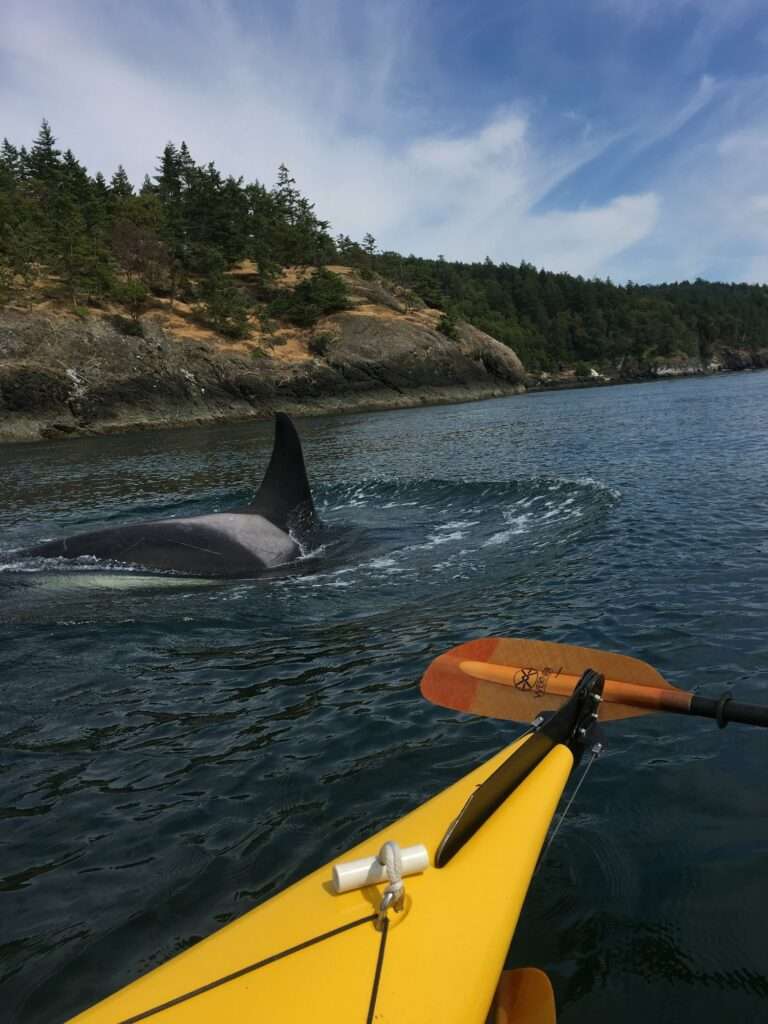Orcas (killer whales) are frequent visitors and residents of the San Juan Islands. We have two distinct “group” of orcas that roam our waters, Residents and Transients. Drifting in a kelp bed with eight ton ‘killer’ whales off your bow can be awe-inspiring and exciting. Encountering these harmless, intelligent and majestic creatures in a sea kayak is both humbling and enlightening and will change your outlook of the natural world forever.
Orcas, or Killer Whales, are unpredictable residents of the islands from late Spring May/June through September. Our three Resident Orca Pods (J, K and L) feed only on salmon, so they are consistently present only when spawning salmon are plentiful. Transient Orca whales feed on marine mammals such as porpoise, sea lions and harbor seals. Transients can be encountered throughout the sea kayaking season in all areas of the San Juan archipelago. Humpbacks are making a steady comeback in the San Juans, and these 40 foot behemoths are an amazing sight from our twenty-one foot sea kayaks. Other whales/mammals playing our waters are gray whales, minke whales, stellar sea lions, harbor seals, river otters and porpoise.
Our Two-Day Orca Quest, Three-Day Coastal Explorer and Four-Day Islands Adventurer expeditions spend a final night camped on the edge of orca whale country and spend two days or one and a half days exploring prime orca habitat. This gives you the best odds possible of encountering orcas in the wild. Viewing “killer whales” from a kayak is one of the most exciting wildlife experiences you will ever have. Our nearly four decades of whale watching experience will put you in a front row seat! The five-day “Ultimate” traverses channels and bays frequently inhabited by humpback, minke and orca whales. Our Lime Kiln Half Day tour and our Lime Kiln Full Day tour take you to the heart of orca country, and, with a little luck, you will paddle with whales! Our Lime Kiln tours launch from San Juan County Park on San Juan Island’s west side where orca pods hunt salmon. Let’s go whale watching!
Orca Feeding in San Juan Islands
Orcas, or killer whales, are predators whose feeding habits depend on whether they belong to ‘resident’ or ‘transient’ pods. Resident orcas are whales that prefer to return to the same coastal areas each summer, while transient orcas constantly swim along the coast in search of food and generally are not observed to spend too much time in the same place. Pods determine feeding habits because these tend to be learned from whales within the pod. For instance, while transient whales prefer preying on mammals like dolphins, seals or porpoises, resident whales feed on salmon. For the large part, transient orcas tend to require a greater intake of food because of their higher energy expenditure compared to the resident orcas, which explains their habit of feeding on other mammals — a habit that only killer whales have. Our local orcas eat about 250 pounds of salmon per day.
The Socially Learned Nature of Orca Feeding Habits
One of the best examples proving that feeding habits are learned within pods is the behavior of transient orcas when held in captivity. One case proved to be particularly interesting for trainers in an oceanarium: a newly captured transient orca kept refusing to eat the fish that trainers were trying to feed it, to the point that it began to starve. Worried that the orca would starve to death, trainers decided to try to place a captive resident orca in the same tank. Only once the captive resident orca presented the transient orca with fish did it recognize fish as a type of food. Without the assistance of the other orca, it probably would have starved to death.
Orca Feeding and Predatory Behavior
Overall, orcas are considered very intelligent creatures and are some of the top predators in the ocean. While some of the fundamentals of their behavior and social life is understood, much surrounding the social dynamics of orcas is still not known because it takes place underwater. Nevertheless, what we do know is that orcas are very social creatures that appear in groups between 3 to 73 whales (super pod-when all three local pods meet and greet, usually early in the season).
Whale watching is one of the most amazing experiences you can have; on any given expedition with San Juan Kayak Expeditions you can witness orcas breaching, spy-hopping, lobtailing or even sleeping. On the San Juan islands, whale watching season lasts from spring to fall. During this time, it becomes possible to see both resident pods and visiting transient orcas in search of food. If you are interested in finding out more about whale watching and what it entails, feel free to contact San Juan Kayak Expeditions.










